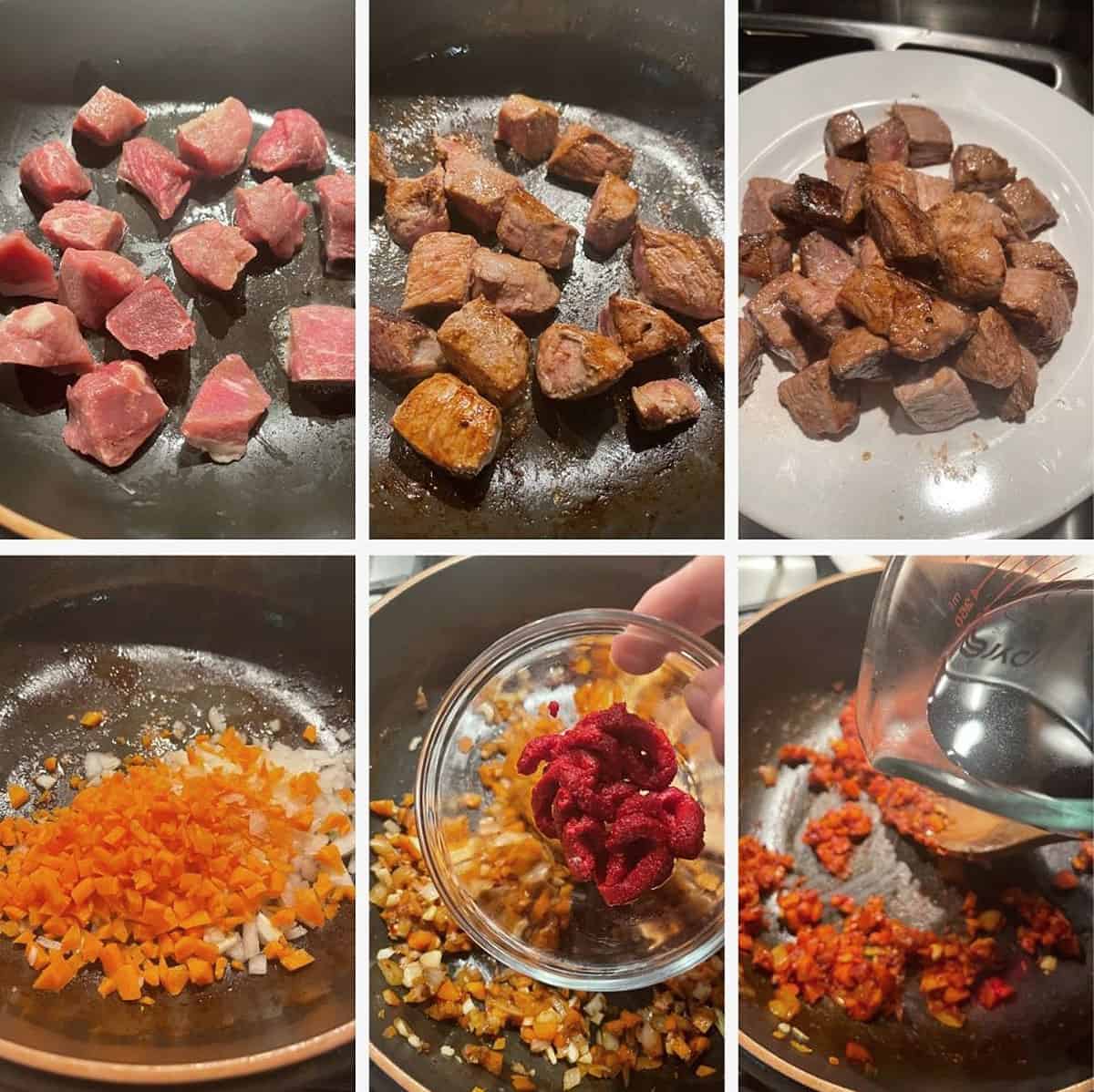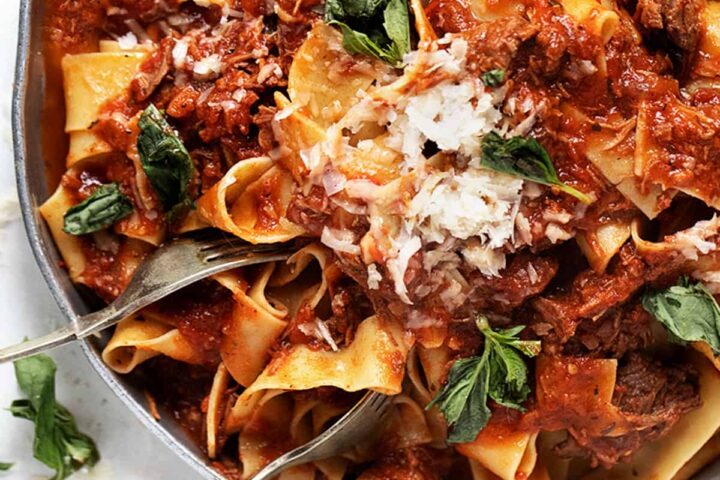Beef Ragu is a classic Italian sauce, with beef cubes and vegetables simmered together with tomatoes, wine and herbs. Serve over pasta or polenta for a classic, hearty and delicious meal.

Every home cook needs a classic beef ragu recipe!
A classic beef ragu recipe will serve any home cook well for many, many years, whether cooking for family or a crowd. Universally loved, hearty and filling, beef ragu is classic comfort food and always a family or crowd pleaser.
Cooked low and slow until the beef basically falls apart, this is one of those dishes where you can do the bulk of the prep mid-day, enjoy the smell all afternoon and just have the few minutes work to cook the pasta to do at dinner time.
That said, I think most people would agree that beef ragu is even better after it has been refrigerated, so don’t hesitate to make it ahead.
And yes! You can easily make this beef ragu in the oven or in a slow-cooker, as well.
Ingredients and substitutions
A few notes about the key ingredients …
Beef – You don’t need to use expensive beef cuts to make a great ragu. Watch for sales on stewing or cubed beef and stock up. Alternately, if beef roasts are on sale, you can buy a small roast and cut it up into cubes. Blade roast (or chuck roast) or any roast that you would use for a pot roast works well.
Canned Tomatoes – Use the best canned tomatoes you can. I love San Marzano canned whole tomatoes, for the best flavour.
Wine – you can use either red or white wine, though I tend to prefer red myself. A nice full-bodied red wine, such as chianti is especially nice. If you don’t have wine or prefer not to use, simply omit and replace with an equal amount of additional beef broth.
Herbs – Fresh herbs are great if you have them, though dried herbs work well. The one place where you might want to spring for fresh it on some fresh basil. I love torn fresh basil as a garnish on this dish. The fresh note of the basil is really nice!
How to make beef ragu sauce
This is a visual summary of the steps to make this recipe. Always refer to the complete instructions in the recipe card below when making the recipe.



Top tip!
Salt brings all the great flavours together! I like to salt a little along the way, but you’ll almost certainly need to add additional salt at the end of cooking. Taste your sauce. Is it smooth and flavourful or a bit acidic and flat? If the latter, add salt, a bit at a time and stirring in between, tasting and adding salt until you get to that smooth spot!
How to make beef ragu in the oven or a slow cooker
The base recipe for this beef ragu cooks on the stove-top in a Dutch oven, but I have included details on how to cook it either in the oven or in a slow cooker in the Recipe Card below, if you prefer.

How to serve or use your beef ragu
With pasta – I love to serve ragu with pappardelle pasta. I just love the pairing of hearty noodles with the hearty sauce. Tagliatelle or fettuccine would also be a good noodle to try.
Over polenta – spoon the flavourful ragu over polenta.
In lasagna – replace your usual ground beef meat sauce with this beef ragu for a hearty twist.
Make an Italian-style Shepherd’s Pie – again, replace the typical ground beef filling of Shepherd’s pie with beef ragù. Top with Parmesan-flavoured mashed potatoes and bake!

Storing and freezing
Left-over beef ragu will keep well for 2-3 days in the refrigerator. In fact, many people think beef ragu tastes even better when made ahead and refrigerated for 12-24 hours.
Beef ragu freezes beautifully in an airtight container up to 3 months. Defrost in the fridge.
Want to save this recipe?
Enter your email and I’ll send it to your inbox. Plus, you’ll get great new recipes from me every week!
By submitting this form, you consent to receive emails from Seasons and Suppers.
You can unsubscribe at any time.

Get the Recipe: Classic Beef Ragu Sauce
Ingredients
- 1 lb stewing beef
- 2 Tablespoons extra virgin olive oil
- 1/3 cup onions, diced
- 1/3 cup carrots, diced, about 1/4-inch dice
- 1/4 teaspoon crushed red chili pepper flakes
- 4 cloves garlic , roughly chopped
- 2 Tablespoons tomato paste
- 1/2 cup red wine
- 28 oz whole canned tomatoes, San Marzano recommended
- 1 cup beef broth
- 2 Tablespoons salted butter
- 1/2 teaspoon dried rosemary
- 1/2 teaspoon dried thyme
- 1/2 teaspoon dried oregano
- 1/2 teaspoon dried basil, or about 6 torn fresh basil leaves
- 1/4 teaspoon salt
- 1 bay leaf
To finish:
- 1 teaspoon red wine vinegar , or balsamic vinegar
- Salt and pepper, as needed
To serve:
- pappardelle, tagliatelle or fettucine pasta, or polenta
- Freshly grated Parmesan cheese
- Torn fresh basil leaves, for garnish
Instructions
- In a large, heavy bottomed pot (such as a Dutch oven), heat the olive oil over medium-high heat. Pat the beef cubes dry and season with some salt and freshly ground pepper. Add the meat to the hot pan in small batches. **You don want to crowd the pan, to avoid too much liquid in the pan, which will prevent the beef from browning. And browning = flavour. So do the beef in about 1/2 lb. batches (so 2 batches for the 1X recipe). Once beef is nicely browned, remove to a plate and set aside. Repeat until all the beef is browned.
- In the same pot, adding a bit more oil, if necessary, cook the onion and carrots, stirring, until softened, about 3-4 minutes. Add the red pepper flakes and garlic and cook for about a minute more. Add tomato paste and stir in, cooking for about 30 seconds. Add the wine and stirring, cook until the wine has reduced by half, about 3 minutes. Add the tomatoes with juices (breaking up the whole tomatoes a bit with a spoon or your hands), beef broth, butter, herbs and salt. Stir until the butter is melted, then add the bay leaf. Return the reserved meat and any juices to the pot. Bring to a boil, then reduce heat to low, cover, and simmer for about 2 1/2 hours, stirring a couple of times during cooking. **Alternately, rather than simmering on the stove-top for 2 1/2 hours, you can transfer the mixture to a slow cooker, to cook (covered), for 3 1/2 – 4 hours on high or 7-8 hours on low, followed by 30 minutes uncovered to thicken. You could also pop the Dutch oven into at 325F oven for about the same 2 1/2 hours as simmering on the stove-top, stirring a couple of times during the oven cooking, then simmer on the stove-top over medium-low heat uncovered at the end, to thicken.
- When the beef is fork-tender, remove and discard the bay leaf, leaving the beef in the pot. Use a potato masher to break up the beef into shreds. Add the vinegar to the pot and increase the heat to medium-low. Simmer the sauce, uncovered, for an additional 30 minutes, or until thickened to your liking.
- Taste the ragu and adjust seasoning to your taste, adding salt especially, as needed. The sauce should be smooth and flavourful. If it tastes flat and acidic, it needs salt. Add a bit at a time and stir in, taste and repeat as needed.
- Meanwhile, cook pasta in a large pot of salted water until al dente. Drain and place pasta into a large bowl. Spoon ragu over pasta, as needed, tossing well to coat the pasta. Allow the pasta to stand several minutes undisturbed in the bowl, to allow the sauce and pasta to "meld together", before serving with Parmesan and some torn basil leaves.
Notes
More pasta recipes to love!
Hi! I’m Jennifer, a home cook schooled by trial and error and almost 40 years of getting dinner on the table! I love to share my favourite recipes, both old and new, together with lots of tips and tricks to hopefully help make your home cooking enjoyable, stress free, rewarding and of course, delicious!







DELICIOUS AND EASY! I used a pressure cooker for the beef and added small portabello mushrooms cut in half, letting all boil covered until it reached the stage when steam comes out robustly and the pressure gage pops up. Then I turned it down to medium-low to maintain a steady steam. The meat was pretty much broken down after 1¾ hours so I didn’t even have to mash it. The mushrooms held up well. I didn’t have any broad, flat pasta so I served it over penne. Husband loved this dish!
So glad you all enjoyed it! Thanks so much :)
This was the perfect spaghetti meal for a large family. I triple the recipe, added meatballs, sausage, and using the leftovers to make lasagna.
Thanks so much for the delicious recipe!!
Sounds lovely! So glad you enjoyed it. Thanks :)
Made this and it was wonderful I did make a few changes, I used a pressure cooker on the meat wanted to insure fit was tender 30 min on pressure cooker then slow cooker for 3 hours it was amazing,
So pleased you enjoyed it Michael! Thanks so much :)
Once again, a hit. Thanks for a taste delicious recipe. I made the quantity suggested and then had lots for the freezer – we are just 2.
I will now be using your suggestions for ragu.
My small beef cubes did not mash well with the potato masher. Ah well, no problem. It was delicious anyway served over pappardelle.
So glad you enjoyed it, Carole Ann. Thanks! I love having extra in the freezer as I know a quick and easy meal is in my future :) When it comes to stewing beef, it’s a bit of a luck of the draw sometimes, depending on what cut they came from. Some mashes better than others.
Hi,
After shredding beef, put it back into sauce or leave it out when the sauce simmers for an additional 30 minutes.
Thank you.
Hi Nancy, only the bay leaf is removed (and discarded). You would leave the beef in the pot and mash/shred it in the pot. Sorry it wasn’t clear in the instructions. I have cleaned that up. Thanks!
This sauce was super delicious! From the first bite of its savory goodness I knew I had found a keeper. I would recommend using maybe rotini or penne for this recipe, just some noodle that will cling to the sauce really well. I used spaghetti and while it was delicious, I found myself wanting a noodle that would hold more sauce.
So glad you enjoyed it, Madelyn :) Thanks so much!
Hi!, I’m confused on when all ingredients are combined and it says to simmer for 2 1/2 hours then next step is put into a slow cooker. Why does it have to simmer for so long and not able to put straight into slow cooker?
Hi April and sorry, my instructions there were not clear. I have updated it now. The slow cooker/oven suggestions were intended as alternatives to simmering on the stove-top for 2 1/2 hours, not in addition to simmering on the stove-top. It should be less confusing now. Thanks for letting me know :)
Hi I was just wondering how much pasta per the recipe please thanks in advance
Hi Nicole, the amount of pasta you use is totally up to you. As a general rule of thumb, about 2 oz. dried pasta per person. That said, when I make this ragu, I like the finished dish to be ragu heavy, so I tend to use less pasta than I normally would. About the only thing you don’t want to do is use too much pasta. You don’t want the ragu to get lost in a lot of pasta.
If one wanted to double the recipe would you double all the ingredients ( that seems to be a lot of garlic and whole canned tomatoes)
Hi Susan and yes, you’d want to double everything to keep the same ratios for the recipe. It may sound like a lot, but you’ll be making a big pot of ragu :)
Love it, it become my home Ravi recipe
Thank you
So glad to hear, Jen :) Thanks so much!
My goodness, this is good! I’ve made other ragu recipes and they were very nice, but this one is seriously over the top. I made it according to the recipe — made a batch and a half since I had more meat. I bought San Marzanos, and used a 14 oz can of Muir Glen diced tomatoes to stretch the sauce to a 1.5 batch. Flavor was outstanding, and I liked using beef cubes rather than a chuck roast. I just think it tasted better after using the potato masher to finish the sauce. Balsamic at the finish was also brilliant. Thank you!
So glad you enjoyed it, Mary :) Thanks so much!
Another great recipe! It was delicious!! Thank you!!!
So glad you enjoyed it, Ryan :) Thanks so much!
Made this today for New Years Day, served it with some homemade gnocchi and it was DELICIOUS! Excellent recipe, easy to follow and great flavor!! Everyone was raving about the sauce, my daughter said I should get a Michelin star lol!! Thanks so much!!
I’m so glad to hear, Nancy! Thanks so much :)